Scientific papers 2022 - Part A

Authors:
Alexandre Guimard, Fabrice Joulia, Fabrice Prieur,
Gauthier Poszalczyk, Kader Helme, and François J.
Lhuissier.
It is well known that the duration of apnea is longer in
static than in dynamic conditions, but the impact of
exercise intensity on the apnea duration needs to be
investigated. The aim of this study was to determine the
relationship between apnea duration and exercise
intensity, and the associated metabolic parameters.
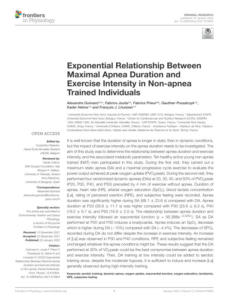

Authors:
Khodor Haidar Hassan, Joelle Azzi, Gian Marco Oppo,
Hadi Raef Rida, Roberto Vecchioni, Mohamad Ali
Chahrour, Mehdi Raef Rida, Fadel Nahle, Hadi Farhat,
Edwin Parra Prada, and Ahmad Najib Ballout.
Hyperbaric Oxygen Therapy (HBOT) is a recommended
treatment for all hypoxic pathologies and has been used
for decades as a recommended treatment for hypoxic-
ischemic and infectious disorders.
The pressures utilized vary from 2.2 to 2.8 ATA. 20
Osteoporosis patients treated underwent HBOT at 1.5 ATA
and 100% oxygen for 15 sessions.
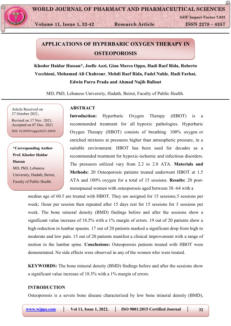

Authors:
Danilo Cialoni, Andrea Brizzolari, Alessandra Barassi,
Gerardo Bosco, Massimo Pieri, Valentina Lancellotti, and
Alessandro Marroni.
Diving can influence changes in several hematological
parameters (HP) but the changes in HP in the
decompression phases are still unclear. This study
investigated any possible relationship between HP and
predisposition to inert gas bubble formation after a single
recreational dive. Blood, obtained from 32 divers, was
tested for differences in white blood cells, granulocytes,
lymphocytes, monocytes, red blood cells, and platelets
between bubblers and non-bubblers.


Authors: Sven Dreyer, Andreas Deussen, Dietmar Berndt,
and Jochen D. Schipke.
In 2012, a severe accident happened during the mission of
a saturation diver working at a depth of 90 m in the North
Sea. The dynamic positioning system of the diver support
vessel crashed, and the ship drifted away from the working
place, while one diver’s umbilical became snagged on a
steel platform and was severed. After 33 min, he was
rescued into the diving bell without exhibiting any
apparent neurological injury. The present case report tries
to reconstruct, on rational grounds, how the diver could
have survived after he was cut off from breathing gas, hot
water, light, and communication while 90 m deep at the
bottom of the sea.
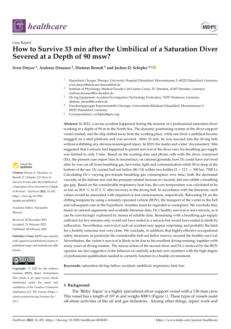

Authors: Anders Rosén, Mikael Gennser, Nicklas Oscarsson,
Andreas Kvarnström, Göran Sandström, Helen
Seeman Lodding, Joel Simrén, Henrik Zetterberg.
This study aimed to determine if established markers of
neuronal injury were increased in the blood after diving.
Thirty-two divers performed two identical dives, 48 h apart,
in a water-filled hyperbaric chamber pressurized to an
equivalent of 42 m of seawater for 10 min. After one of the
two dives, normobaric oxygen was breathed for 30 min,
with air breathed after the other. Blood samples were
obtained before and at 30–45 and 120 min after diving.
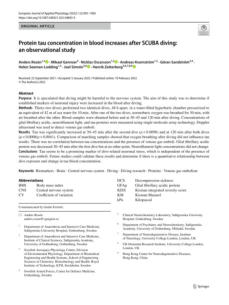

Authors:
Jerka Dumi, Ana Cvetko, Irena Abramovi, Sandra Šupraha
Goreta, Antonija Perovi , Marina Njire Braticevi, Domagoj
Kifer, Nino Sincic, Olga Gornik, and Marko Žarak.
A previous publication of the authors suggested that
repeated diving triggers an adaptive response of the
cardiovascular and immune
systems. To elucidate further molecular events underlying
cardiac and immune system adaptation and exclude
possible adverse effects, the authors measured blood levels
of specific cardiac and inflammation markers.
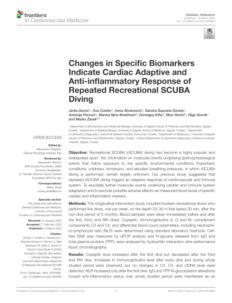

Authors:
Hugo F. Posada-Quintero, Carol S. Landon, Nicole M.
Stavitzski, Jay B. Dean, and Ki H. Chon.
The authors tested the hypothesis that changes in
electrodermal activity (EDA), a measure of sympathetic
nervous system activation, precedes seizures in rats
breathing 5 atmospheres absolute (ATA) HBO 2 . Radio
telemetry and a rodent tether apparatus were adapted for
use inside a sealed hyperbaric chamber.
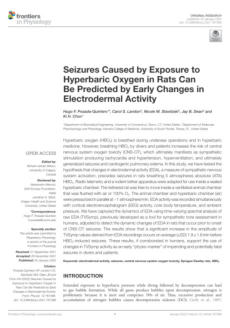

Authors:
Linjie Wei, Chi Lin, Xingsen Xue, Shiju Jila, Yalan Dai, Li Pan,
Wei Wei, Guodong Dun, Yong Shen, Taoxi Zong, Jingjing
Wu, Yafang Li, Lixia Wu, Jishu Xian 3 and Anyong Yu
IThe prognosis of hypertensive intracerebral hemorrhage
(HICH) is poor at high altitudes. The objective of this study
was to explore whether hyperbaric oxygen (HBO) can
improve the results of computed tomography perfusion
(CTP) imaging and the neurological function of patients
with HICH, and influence the hemoglobin concentration.
This document is not directly related to diving. However, it
allows us to better understand the effect of oxygen on the
human body.
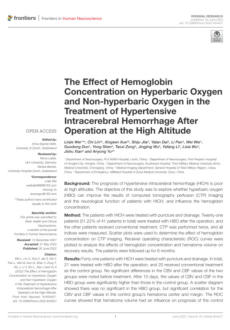

Authors:
Kate Lambrechts, Peter Germonpré, Joaquim
Vandenheede, Manon Delorme, Pierre Lafère, and
Costantino Balestra.
Despite evolution in decompression algorithms,
decompression illness is still an issue nowadays. Reducing
vascular gas emboli (VGE) production or preserving
endothelial function by other means such as diving
preconditioning is of great interest. Several methods have
been tried, either mechanical, cardiovascular, desaturation
aimed or biochemical, with encouraging results. In this
study, the authors tested mini trampoline (MT) as a
preconditioning strategy.
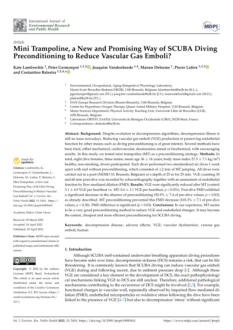

Authors:
Simon J. Mitchell, Michael H. Bennett, and Richard E.
Moon
Decompression sickness from dissolved gas causes tissue
and vascular injury after a reduction in environmental
pressure may occur in diving, aviation, and space flights.
Arterial gas embolism, in which bubbles introduced into
the arterial circulation cause multifocal ischemia, may
occur after diving-related, iatrogenic, accidental
pulmonary barotrauma or by the direct iatrogenic
introduction of gas into the vasculature. Because it may be
difficult to clinically differentiate decompression sickness
from an arterial gas embolism in divers and the treatment
protocols for the two disorders are the same, the term
decompression illness” is sometimes used to indicate the
presence of decompression sickness, arterial gas
embolism, or both, but the separate terms are used here.
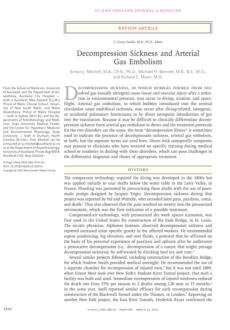

Author: Paul G. Harch
This paper is a systematic review of hyperbaric oxygen
therapy (HBOT) in Persistent Postconcussion Syndrome, a
condition with significant consequences and limited
treatment options, using a dose-analysis based on the
scientific definition of hyperbaric oxygen therapy as a dual-
component drug composed of increased barometric
pressure and hyperoxia.
This document is not directly linked to diving. However, it
allows for a better understanding of the properties of
oxygen and its potential usage in the treatment of injuries.
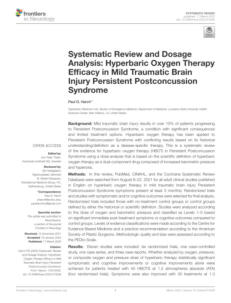

Authors: Feiko J. M. de Jong, Thijs T. Wingelaar, Paul
Brinkman, Pieter-Jan A. M. van Ooij, Anke-Hilse
Maitland-van der Zee, Marcus W. Hollmann, and
Rob A. van Hulst
The hyperbaric oxygen treatment USN table 6 can have
adverse effects, such as pulmonary oxygen toxicity (POT). It
is caused by reactive oxygen species ’ damaging effect on
lung tissue and is often experienced after multiple days of
therapy. The subclinical pulmonary effects have not been
determined. The primary aim of this study was to measure
volatile organic compounds (VOCs) in breath, indicative of
subclinical POT after a table 6 implementation. Since the
exposure would be limited, the secondary aim of this
study was to determine whether these VOCs decreased to
baseline levels within a few hours.


Authors:
Kamellia Karimpour, Rhiannon J. Brenner, Grant Z. Dong,
Jayne Cleve, Stefanie Martina, Catherine Harris,
Gabriel J. Graf, Benjamin J. Kistler, Andrew H.
Hoang, Olivia Jackson, Virginie Papadopoulou, and
Frauke Tillmans.
Venous gas emboli (VGE) are a marker of decompression
stress, and large amounts of VGE are associated with an
increased probability of Decompression Sickness (DCS).
Thus, there is a need for small, portable devices with long
battery lives to obtain ultrasonic data in the field to assess
this variability better.
The authors compared two new handheld ultrasound
devices against a standard device currently used to
monitor post-dive VGE in the field.
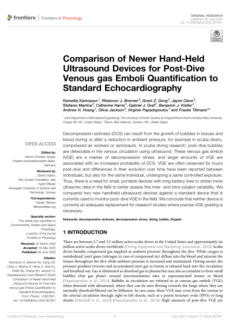

Authors:
Gordon Slater, Martin O’Malley, Tayla Slater, and Tandose
Sambo.
Hyperbaric Oxygen Therapy (HBOT) has been a
recognized treatment for a multitude of injuries for
decades and presents significant opportunities for the
improvement of wound healing, blood vessel restoration,
reduction in recovery time after surgery, treatment of
neurological and neurodegenerative disorders,
improvement of memory and cognition, sports injury
rehabilitation, cartilage regeneration, and overall quality of
life. This paper investigates HBOT and its indications for
use.
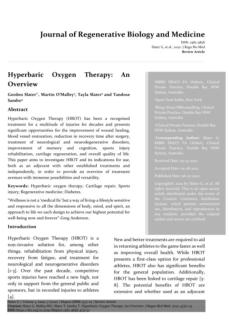

Authors:
Zachary M. Harris, Ying Sun, John Joerns, Brian Clark, Buqu
Hu, Asawari Korde, Lokesh Sharma, Hyeon Jun Shin,
Edward P. Manning, Lindsey Placek, Derya Unutmaz, Gail
Stanley, Hyung Chun, Maor Sauler, Govindarajan
Rajagopalan, Xuchen Zhang, Min-Jong Kang, and
Jonathan L. Koff
Studies have linked severe hyperoxia, or prolonged
exposure to very high oxygen levels, with worse clinical
outcomes. This study investigated the role of epidermal
growth factor receptor (EGFR) in hyperoxia-induced lung
injury at very high oxygen levels (>95%)
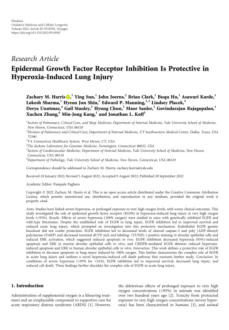

Authors:
Enrico Marchetti, Daniela Pigini, Mariangela Spagnoli,
Giovanna Tranfo, Flavia Buonaurio, Fabio Sciubba, Ottavia
Giampaoli, lfredo Miccheli, Alessandro Pinto, Nazzareno
De Angelis, and Luigi Fattorini
Oxidative stress after scuba diving has been explored by
measuring urinary biomarkers in volunteers under
controlled conditions. Dive depth and duration, water
temperature, and workload are all variables that can elicit
metabolic responses. A controlled diving experiment was
performed in an indoor pool at 20, 30, and 40 m depths at
a water temperature of 32C on three different days.
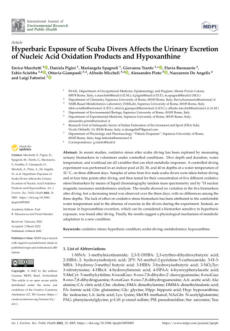

Publisher: Agilent - https://www.agilent.com/en
Reactive oxygen species (ROS) have long been known to
be a component of the killing response of immune cells to
microbial invasion. Recent evidence has shown that ROS
play a key role as a messenger in normal cell signal
transduction and cycling. These reactive molecules are
formed by several different mechanisms
and can be detected by various techniques. This white
paper briefly describes the biology behind some of these
molecules and the means for their detection.


Authors:
Ningfang Lian, Sijiao Wang, Lijuan Hu, Liping Xue, Ying
Gong, Li Li, Yanjie Yang, and Lei Zhu
This study aimed to evaluate the effects of a 500 m
simulated single saturation dive on lung function.
Nine professional divers aged (36 ± 7) years were enrolled.
Three days after the dive, the parameters related to
expiratory flow forced vital capacity (FVC)) were
decreased; the parameters about small airway function
decreased compared to those before the dive.
Additionally, after the dive, the parameters related to
pulmonary diffusion function were decreased compared
with those before the dive.,
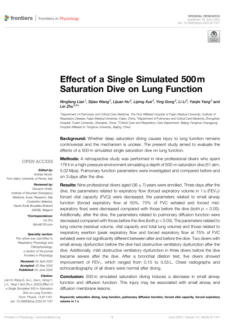

Authors: Ran Arieli
The authors of this study suggested a mechanism for distal
arterial bubble formation (Arieli and Marmur 2017). In the
bifurcating arterial tree, the vessel’s wall becomes thinner,
and wall surface to the volume of the vessel increases.
Both of these enhance nitrogen diffusion from the
surrounding tissue into the blood.
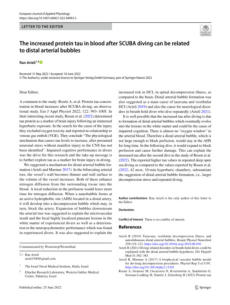

Authors:
Sérgio Rhein Schirato, Vitor Silva, Kátia Iadocicco,
Alessandro Marroni, Massimo Pieri, Danilo Cialoni, José
Guilherme Chaui-Berlinck
The present study aims to put forward a mathematical
model of bubble formation associated with an
inflammatory process related to decompression. The
model comprises four state-variables (inert gas pressure,
inert gas bubbles, proinflammatory and inflammatory
factors) in a set of non-linear differential equations.
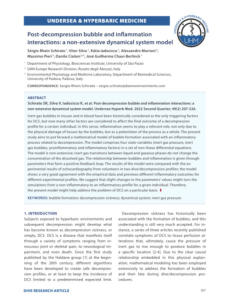

Authors: Brieuc Bonnemaison , Olivier Castagna, Sébastien
de Maistre, and Jean-Éric Blatteau
The presence of intra-pulmonary air lesions such as cysts,
blebs and emphysema bullae, predisposes to pulmonary
barotrauma during pressure variations, especially during
underwater diving activities. Chest radiography has long
been the baseline examination for the detection of
respiratory pathologies in occupational medicine. It has
been replaced since 2018 by the thoracic CT scan for
military diving fitness in France.
The objective of this work was to evaluate the prevalence
of the pulmonary abnormalities of the thoracic CT scan
and to relate them to this population's characteristics and
the spirometry results


Authors:
Feiko J. M. de Jong, Paul Brinkman, Thijs T. Wingelaar,
Pieter-Jan A. M. van Ooij, and Rob A. van Hulst
Diving or hyperbaric oxygen therapy with increased partial
pressures of oxygen (pO2) can have adverse effects such
as central nervous system oxygen toxicity or pulmonary
oxygen toxicity (POT). One of the most promising
techniques to determine early signs of POT is the analysis
of volatile organic compounds (VOCs) in exhaled breath.
This study aimed to reanalyze the data of five previous
studies to compose a library of potential exhaled markers
for early POT detection.
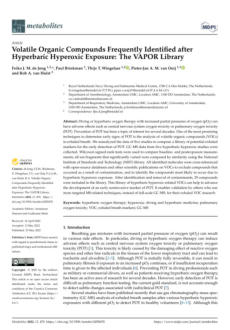

Authors: Maria Ludovica Carerj, Giuseppe Bucolo, Silvio
Mazziotti, Alfredo Blandino, Christian Booz,
Giuseppe Cicero, Tommaso D’Angelo.
Pneumothorax and pneumomediastinum are life-
threatening conditions especially in critically ill patients.
One of the most common situations in which they occur is
prolonged invasive and non-invasive mechanical
ventilation with high end-expiratory pressure. Probably
due to the high number of patients with SARS-CoV-2
respiratory infection being treated with mechanical
ventilation, increasing number of pulmonary barotrauma
cases have been reported.
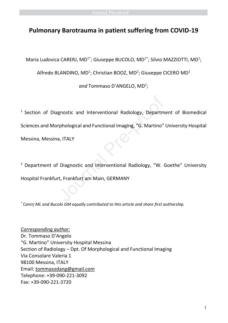

Authors:
Dhan Bahadur Shrestha, Yub Raj Sedhai, Pravash
Budhathoki, Ayush Adhikari, Nisheem Pokharel, Richa
Dhakal, Satyasuna Kafle, Wasey Ali Yadullahi Mir, Roshan
Acharya, Markos G. Kashiouris, Mark S. Parker
Numerous studies have reported an increased incidence
of spontaneous pulmonary barotrauma, such as
pneumothorax, pneumomediastinum, and subcutaneous
emphysema in patients with COVID-19. The authors
conducted this systematic review and meta-analysis to
assess the value and significance of the available data.
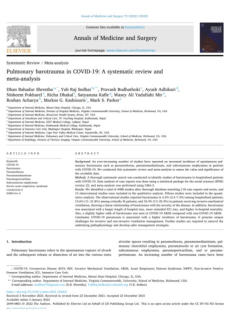

Authors:
Sergio A Angelini, Lorenzo Tonetto, Michael A Lang
In dissolved gas decompression algorithms, the ceiling is
the depth at which the dissolved gas pressure in at least
one tissue equals the maximum tolerated value defined by
the algorithm. Staged decompression prescribes stationary
stops in three-metre intervals so as to never exceed this
maximum tolerated value. This keeps the diver deeper than
the ceiling until the ceiling itself decreases to coincide with
the next, three-metre shallower stage. Ceiling-controlled
decompression follows the ceiling in a continuous ascent.
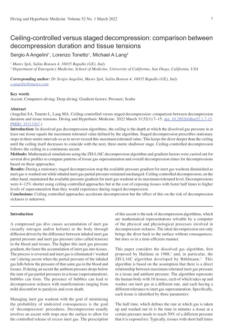

Diving and Hyperbaric Medicine said:
We write to inform the community of an update to our
previously published guidelines in Diving and Hyperbaric
Medicine regarding evaluation of divers who have
recovered from COVID-19. 1 We originally developed
these guidelines for the dive clinic at the University of
California, San Diego (UCSD).

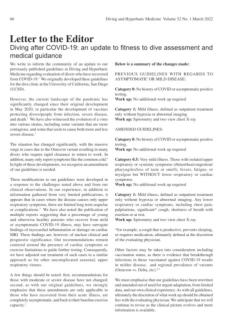

Authors:
Ian L Millar, Folke G Lind, Karl-Åke Jansson, Michal
Hájek, David R Smart, Tiago D Fernandes, Rosemary A
McGinnes, Owen D Williamson, Russell K Miller, Catherine
A Martin, Belinda J Gabbe, Paul S Myles, Peter A Cameron,
for the HOLLT investigator group
Hyperbaric oxygen treatment (HBOT) is sometimes used in
the management of open fractures and severe soft tissue
crush injury, aiming to reduce complications and improve
outcomes. - Patients with open tibial fractures were
randomly assigned within 48 hours of injury to receive
standard trauma care or standard care plus 12 sessions of
HBOT. The primary outcome was the incidence of necrosis
or infection or both occurring within 14 days of injury.



Authors:
Karin Biering, Kent J. Nielsen, Ole Carstensen, & Anette
Kærgaard
To examine whether demographic and health factors are
associated with risk of electrical shocks and compared
mental and physical health before and after an electrical
shock, a 6-month cohort study of 6960 electricians
involved weekly questionnaires regarding exposure to
electrical shocks, and health. The authors examined the
association between health and demographic factors and
the risk of eventual electrical shocks and health before and
after a shock.


Authors: Luis-Miguel Pascual-Gomez, Lauren Petrass
This scoping review aimed to identify common drowning
characteristics to support bystanders in recognizing
drowning.
Studies were identified through a systematic search of
databases from the year 2000 until 2020, with the review
guided by the PRISMA Scoping review process. Two
hundred and nineteen potentially relevant articles were
identified, of which 23 met all inclusion criteria.
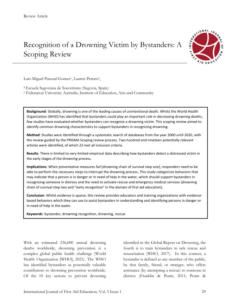

Authors:
Nanna Yr Arnardottir, Sigridur Sia Jonsdottir, Hannes
Petersen
The working environment abroad a ship is unique, with
constant stimuli such as rolling of the vessel, noise, and
vibration.
The objective of this study is to explore the impact of
seasickness-related symptoms, i.e., seasickness, seasickness
symptoms and “mal de debarquement” on seaman´s
health, and how their working environment may affect
those factors.
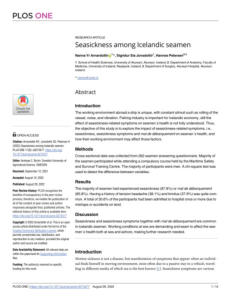

Authors: Connor TA Brenna, Shawn Khan, George
Djaiani, Jay C Buckey Jr. , Rita Katznelson
Respiratory injury during or following hyperbaric oxygen
treatment (HBOT) is rare, but associated pressure changes
can cause iatrogenic pulmonary barotrauma with
potentially severe sequelae such as pneumothoraces.
Pulmonary blebs, bullae, and other emphysematous
airspace abnormalities increase the risk of respiratory
complications and are prevalent in otherwise healthy
adults.
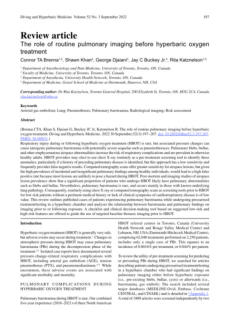

Authors:
Johan Ullman, David Hengst, Ronald Carpenter, Yohan
Robinson
Many operators of professional high-speed boats suffer
severe, acute, and permanent injuries caused by
slamming-induced hull impacts. As the number of
professional high-speed boats and their speed capabilities
increase, operators are reporting increasing numbers and
severity of injuries. However, the actual incidence rate of
acute injuries and the prevalence of chronic
musculoskeletal disorders are still unknown.
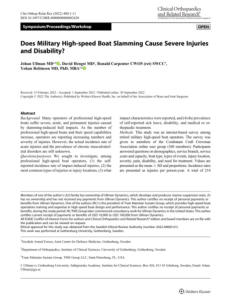

Authors:
Amilkar Almanza-Hurtado, Camilo Polanco Guerra, Marıa
Cristina Martınez-Avila, Diana Borre-Naranjo, Tomas
Rodrıguez-Yanez, and Carmelo Dueñas-Castell
Hypercapnia is the elevation in the partial pressure of
carbon dioxide (PaCO2) above 45 mmHg in the
bloodstream, pathophysiological mechanisms of
hypercapnia include the decrease in minute volume, an
increase in dead space, or an increase in carbon dioxide
(CO2) production per sec. They generate a compromise at
the cardiovascular, cerebral, metabolic, and respiratory
levels with a high burden of morbidity and mortality. It is
essential to know the triggers to provide therapy directed
at the primary cause and avoid possible complications.
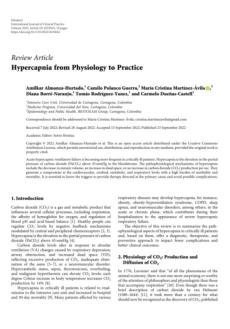

Authors: Najmuddin Noorzad , Sırrı Sunay Gürleyük
With the increasing growth of industrialization and
mechanization of workplaces, electric accidents are
becoming quite common, and many workers and
individuals are unaware of the potential electrical hazards
that their workplaces present and increase their
vulnerability. Electrical currents have a wide range of
impacts on the human body, from a barely slight tingling
to sudden cardiac arrest.
Therefore, a sound understanding of the engineering
perspective and the occupational health and safety risk
assessments are essential to prevent and manage these
hazards.
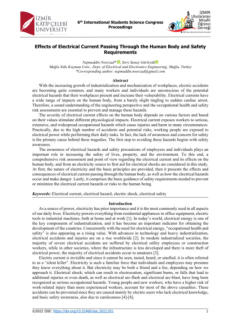

Authors:
(W. Rainey Johnson, Nicholas G. Roney, Hanbing Zhou,
Geoffrey E. Ciarlone, Brian T. Williams, William T. Green,
Richard T. Mahon, Hugh M. Dainer, Brett B. Hart, Aaron A.
Hall
In severe decompression illness (DCI) cases, the central
nervous system is often compromised (>80%), making DCI
among the most morbid of diving-related injuries. While
hyperbaric specialists suggest initiating recompression
therapy with either a Treatment Table 6 (TT6) or 6A (TT6A),
the optimal initial recompression treatment for severe DCI
is unknown.
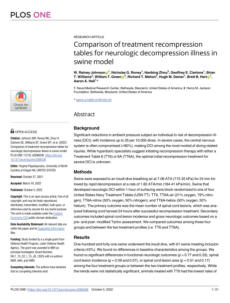

Authors:
Gerardo Bosco,Tommaso Antonio Giacon, Nazareno
Paolocci, Alessandra Vezzoli, Cinzia Della Noce, Matteo
Paganini, Jacopo Agrimi, Giacomo Garetto, Danilo
Cialoni, Natalie D’Alessandro, Enrico M. Camporesi,Simona
Mrakic-Sposta
Divers can experience cognitive impairment due to inert
gas narcosis (IGN) at depth. Brain-derived neurotrophic
factor (BDNF) rules neuronal connectivity/metabolism to
maintain cognitive function and protect tissues against
oxidative stress (OxS). Dopamine and glutamate enhance
BDNF bioavailability. Thus, the authors hypothesized that
lower circulating BDNF levels underpin IGN in divers,
while testing if BDNF loss is associated with increased OxS.
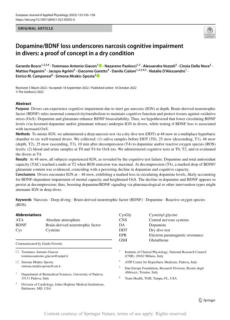

Authors:
Gianluca Paternoster, Gianfranco Belmonte, Enrico
Scarano, Pietro Rotondo, Diego Palumbo , Alessandro
Belletti, Francesco Corradi , Pietro Bertini, Giovanni
Landoni, Fabio Guarracino
This is an observational, case-control study.
Consecutive COVID-19 patients who underwent chest
CT scan at hospital admission during the study time
period (October 1st, 2020 – April 31st, 2021) were
identified.
Macklin effect accuracy for prediction of spontaneous
barotrauma was measured in terms of sensitivity,
specificity, positive (PPV) and negative predictive values
(NPV)..
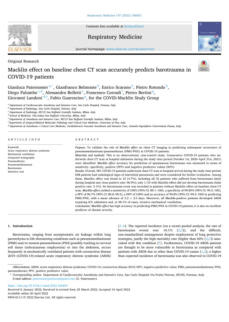

Authors: Mohsen Shafiepour, Mohammad Javad
Najafzadeh, Seyed Mehdi Hashemi Bajgani,
Behnam Dalfardi
Patients with Coronavirus disease 2019 (COVID-19)
pneumonia are at risk of hypoxemic respiratory failure.
Hence, many patients may require noninvasive positive
pressure ventilation (NIPPV) during their hospital course.
Using mechanical ventilation to provide NIPPV may result
in adverse events, including barotrauma.
Two cases of severe COVID-19 pneumonia and
hypoxemic respiratory failure were complicated by
barotrauma that manifested with "pneumoscrotum", a rare
medical condition in which gas accumulates in the
scrotum, an element of the male reproductive structure
located at the base of the penis.






Authors: Levent Demir & Mustafa Avci
The objective of the study was to compare pulmonary
function tests results of hyperbaric chamber inside
attendants (HCIAs) working in a hyperbaric chamber
before and after sessions.
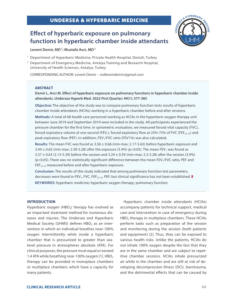

Authors: Xavier C. E. Vrijdag, Hanna van Waart,
Chris Sames, Simon J. Mitchell, & Jamie W. Sleigh
This study evaluated whether hyperbaric oxygen causes
similar narcotic effects to nitrogen, and investigated
oxygen's hyperexcitability effect.
Twelve human participants breathed “normobaric” air and
100% oxygen, and “hyperbaric” 100% oxygen at 142 and
284 kPa, while psychometric performance,
electroencephalography (EEG), and task load perception
were measured. EEG was analyzed with functional
connectivity and temporal complexity algorithms.
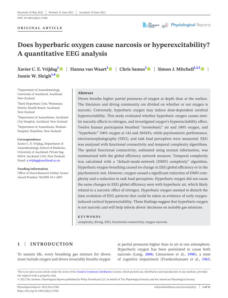


Authors:
Stella E. Hines, Joanna M. Gaitens, Clayton H. Brown,
Danielle R. Glick, Katherine H. Chin, Maxwell A. Reback,
Melissa A. McDiarmid
Blast lung overpressure has received interest as a cause of
chronic respiratory disease in Service members who
deployed in support of U.S. military operations in
Southwest Asia and Afghanistan since 2001. The authors
studied whether veterans who experienced blast exposure
report more chronic respiratory symptoms and di-
agnoses compared to deployed veterans who did not.


Authors: Saleh Eltarabily
The purpose of this study was to determine whether there
is a correlation between a hyperbaric environment, or
increased oxygen partial pressure, and the corrosion of
dental alloys used for dental restorations in divers.
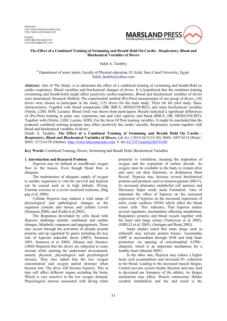

Authors: Dr. med. Jens Strohäker, Dr. med. Malte Bongers,
Dr. med. Robert Bachmann
A 63-year-old man experienced a coughing fit and felt a
tearing sensation in the right hemithorax. Clinical
examination showed thoracic instability with attenuated
breath sounds and an extensive soft tissue hematoma. The
patient’s dyspnea worsened, and he was transferred to
Tübingen University Hospital for surgery.
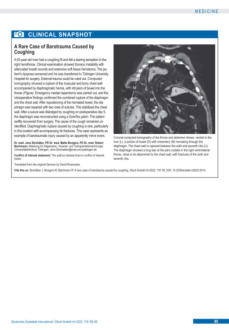

Authors:
Jochen D. Schipke, Thomas Muth, Clark Pepper, Johannes
Schneppendahl, Martin Hoffmanns, Sven Dreyer
Hyperoxia has been described to induce bradycardia
through direct stimulation of the parasympathetic nervous
system. Also, hyperoxia has been found to increase blood
pressure through an elevation of vascular resistance.
However, the latter effect itself would induce bradycardia
through baroreceptor stimulation. This study aims to
evaluate the correlation between these effects by
investigating the relationship between oxygen (O2)
administration and heart rate over time.
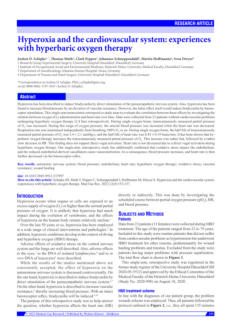

Authors:
Nan-Chieh Huang, Yu-Lung Wu, and Ren-Fang Chao
Hyperbaric oxygen therapy (HBOT) is a professional
medical regimen with a wide range of clinical applications
in various research fields. In addition to treating diving-
related decompression sickness and air embolism, HBOT is
used as an adjunct in the management of various
diseases.
A large number of studies have been published to confirm
its efficacy. Although HBOT has been clinically applied to
the treatment of many diseases, the effectiveness of these
treatments remains controversial.
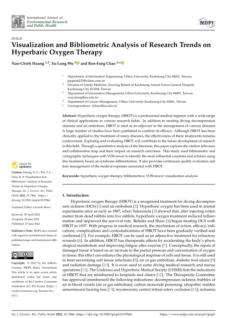

Click here

Click on the octopus
to return to the top
of the page



Authors: Anne-Virginie Desruelle, Sébastien de Maistre,
Sandrine Gaillard, Simone Richard, Catherine
Tardivel, Jean-Charles Martin, Jean-Eric Blatteau,
Alain Boussuges, Sarah Rives, Jean-Jacques Risso,
and Nicolas Vallee
The authors studied a conventional strain of rats resistant
to accidental hyperbaric exposure and hypothesized that
the metabolomic signature might correspond to a
physiological response adapted to the stress induced by
diving. The aim was to verify and characterize whether the
cecal compounds of rats resistant to the provocative dive
have a cecal* metabolomic signature different from those
of non-diving rats. (*cecal: pouch-like structures in the
large intestine that play a crucial role in the digestion of
carbohydrates and the production of fatty acids)
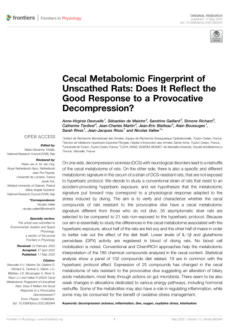

Authors: Giuliana Spadaro, Ilaria Tiddi, Simon Columbus,
Shuxian Jin, Annette ten Teije, CoDa Team, and
Daniel Balliet
The authors describe the Cooperation Databank, a
concept they created that defines and relates concepts in
cooperation research and can represent the relationships
between the results of correlational and experimental
studies. This research platform allows users to retrieve
studies, test the relationship between variables and
cooperation, visualize the results, and perform meta-
analyses, meta-regressions, estimates of publication bias,
and statistical power analyses for future studies. This study
should be considered as a guideline for creating research
and company management databases.
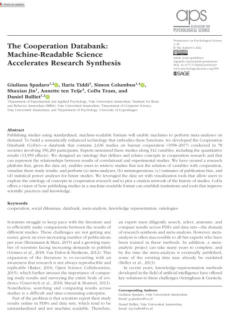

Authors: lan G. Fraser, Mark J. Monaghan, Antonius F.W.
van der Steen, and George R. Sutherland
The authors of this document have compiled a timeline
and summary of key developments in various
echocardiography techniques, linking them to original
publications and historical accounts by early researchers.
The success of echocardiography has largely depended
on technological advances and effective collaboration
between engineers and clinicians, allowing open
exchange across centres and disciplines. Today, advances
are as much about software as hardware, with ongoing
collaboration essential to address unmet needs and assess
the impact of new imaging techniques.
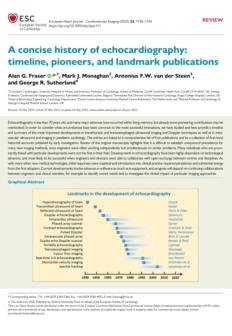






Authors: Santiago Veiga, Robin Pla, Xiao Qiu, David
Boudet, and alexandre Guimard
The authors of this study examined the effects of changes
in underwater sections of swimming races on the
physiological and biomechanical parameters of
competitive swimmers. The results indicate that while
overall performance was maintained and underwater
section durations increased as expected, heart rate and
blood lactate concentration did not differ significantly
between conditions. However, perceived exertion was
higher in constrained underwater than free underwater
conditions, leading to the conclusion that controlled
increases in underwater sections can optimize
performance despite a slight increase in perceived
discomfort.
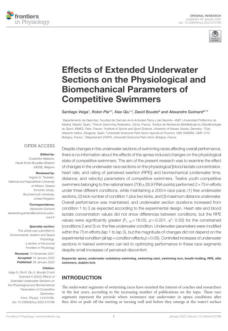

Authors:
Robert P. Ostrowski, Emanuela Pucko and Ewa Matyja
This study investigates the role of the proteasome in
hyperbaric oxygen preconditioning (HBO-PC) to protect
the brain from ischaemic injury. It documents experiments
in male Wistar rats subjected to global cerebral ischaemia
and preconditioned with HBO and details the methods,
results, and significance of the findings, highlighting that
HBO-PC reduces neuronal damage and improves
functional outcomes, possibly through proteasome
involvement and modulation of apoptosis-related
proteins.
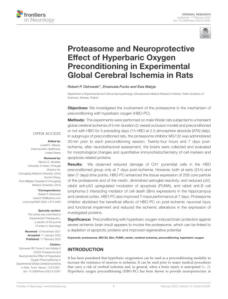

Authors:
Mirela Zec, Vesna Anticevic, Linda Lušis Kalcina, Zoran
Valic, Joško Božic
This study investigates the relationship between negative
automatic thoughts, negative emotions, and
psychophysiological stress responses in military and
recreational divers to determine whether these
psychological factors, rather than diving experience,
contribute to variations in stress responses, as measured by
anxiety levels and cortisol secretion. It also highlights the
importance of considering cognitive and emotional
experiences, especially in recreational divers, to prevent
negative stress responses before diving.
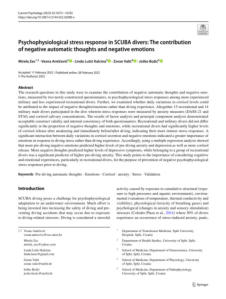

Authors:
Xavier C. E. Vrijdag, Hanna van Waart, Rebecca M. Pullon,
Chris Sames, Simon J. Mitchell, and Jamie W. Sleigh
This study investigates the effects of nitrogen narcosis on
cognitive function during hyperbaric conditions, using
electroencephalogram (EEG) functional connectivity
metrics by comparing the effects of breathing air, which
contains nitrogen, and heliox, which does not have
narcotic effects at the pressure mwentioned. The findings
suggest that nitrogen narcosis increases functional
connectivity in the brain, which is associated with cognitive
impairment, while heliox does not cause such changes.
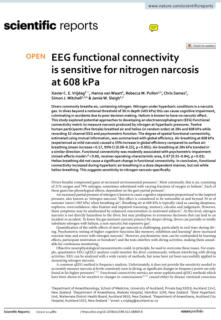

Authors:
Shodai Moriyama, Masashi Ichinos, Kohei Dobashi, Ryoko
Matsutake, Mizuki Sakamoto, Naoto Fuji, Takeshi Nishiyasu
This study investigated the effects of increased arterial
carbon dioxide pressure on vascular and blood flow
responses in the cerebral circulation and active skeletal
muscles during dynamic exercise in humans by comparing
hypercapnia and normocapnia trials to observe differences
in blood flow and vascular conductance in the brain and
exercising muscles. The results highlight contrasting
vascular responses in the cerebral circulation and skeletal
muscles under hypercapnic conditions.
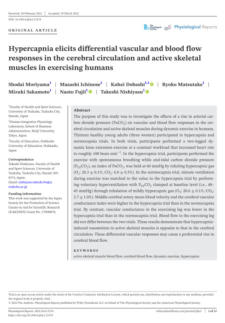

Authors: Danilo A. Massini, Danilo Scaggion, Thiago P. de
Oliveira, Anderson G. Macedo, Tiago A. Almeida,
Dalton M. Pessôa Filho.
The authors of this document present the findings of a
systematic review and meta-analysis that aimed to identify
and evaluate the effectiveness of different training
methods used to improve static apnea time performance
in freediving. The review summarizes the evidence
acquisition and synthesis, highlighting the effectiveness of
three different training methods, and concludes that while
all methods were effective, it is not possible to recommend
an ideal protocol for improving apnea time and freediving
performance based on the existing studies.
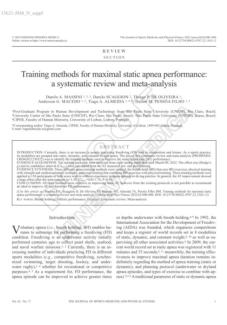

Author: Hamed Taherdoost
This document provides information about the importance
of designing an effective questionnaire for research
studies, outlining the challenges researchers face in
questionnaire design and aiming to review the main steps
involved in creating a questionnaire. This includes defining
the information required, identifying the type of survey and
questions, writing questions, constructing the
questionnaire, pre-testing, and finalizing it for conducting a
study.
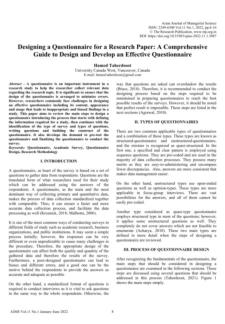

Authors:
Paul-Alexandre Moyaux, Gabriel Fernandez de Grado,
Anne-Marie Musset, Damien Offner
This study assessed the prevalence of orofacial problems
among civilian SCUBA divers in France and analyzed their
dental preventive behaviors, highlighting the frequency of
oral issues related to diving, such as barodontalgia and
dental fractures, and emphasizing the importance of
dental examinations to reduce these problems. The text
also points out a gap in divers' awareness and utilization of
preventive dental care.
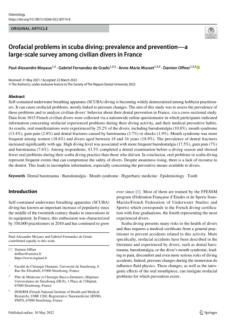
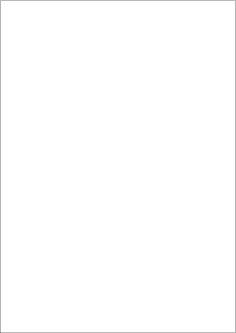


6 - Does hyperbaric oxygen therapy facilitate peripheral nerve
recovery in upper extremity injuries? A prospective study of 74
patients.
Authors: Bilsev Ince, Majid Ismayilzada, Abdullah Arslan,
Mehmet Dadaci
This study assessed the effectiveness of hyperbaric oxygen
therapy (HBOT) in upper extremity nerve injuries. Patients
with ulnar and median nerve injuries from 2015 to 2019
were included and divided into two groups: one received
HBOT after surgery, while the other did not. Follow-ups
were done at 3, 6, and 12 months using various tests.
Results showed that the HBOT group had faster nerve
recovery and better muscle strength than the group
without HBOT, suggesting that HBOT is beneficial.




18 - Simulating Multi-Scale Pulmonary Vascular Function by
Coupling Computational Fluid Dynamics With an Anatomic
Network Model
Authors: Behdad Shaarbaf Ebrahimi, Haribalan Kumar,
Merryn H. Tawhai, Kelly S. Burrowes, Eric A.
Hoffman, and Alys R. Clark
The pulmonary circulation transports blood through
vessels of different sizes, with mechanisms affecting flow.
Few models address the physics of blood flow across
these scales. The presented multi-scale model represents
3D blood flow and capillary perfusion factors, predicting
how changes affect flow distribution and gas exchange. It
also estimates posture's impact on artery wall shear stress,
predicting variations of 0. 75 – 1. 35 dyne/cm².

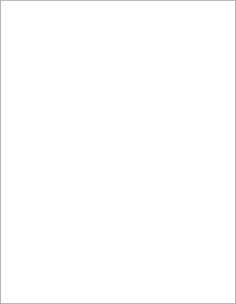

2 - Editorial: The Role of Reactive Oxygen Species in Protective
Immunity
Authors: Denis Martinvalet, and Michael Walch
Reactive oxygen species (ROS) are a type of oxygen
reduction that contributes to various physiological
processes, including inflammation, vasoconstriction, signal
transduction, cell migration, differentiation, and
proliferation. They can modulate genes expression and
transcriptional levels, and regulate gene expression at the
posttranscriptional level. ROS are crucial for cell biology,
organ function, and system physiology, including the
immune system. This Research Topic aims to explore how
ROS contribute to protective immunity, despite their
potential harm.
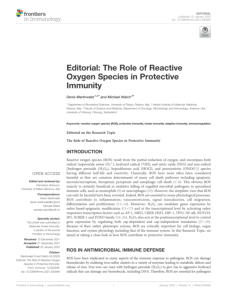



31 - VOxygen Uptake Measurements and Rate of Perceived Exertion
During a Marathon
Authors: Véronique Billat, Luc Poinsard, Florent Palacin,
Jean Renaud Pycke, and Michael Maron
This study focused on recreational marathon runners
and analyzed their breath-by-breath gas exchange
during the race. It found that only respiratory frequency
and heart rate steadily increased, while oxygen uptake
varied among individuals. The results suggest that
runners should pace themselves using their Rate of
Perceived Exertion (RPE)..












